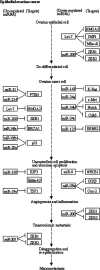miR-34a-FOXP1 Loop in Ovarian Cancer
- PMID: 37546627
- PMCID: PMC10399168
- DOI: 10.1021/acsomega.3c03867
miR-34a-FOXP1 Loop in Ovarian Cancer
Abstract
Ovarian cancer (OC) is the main cause of gynecological cancer mortality in most developed countries. microRNA (miR) expression dysregulation has been highlighted in human cancers, and miR-34a is found to be downregulated and associated with inhibition of tumor growth and invasion in several malignancies, including OC. The winged helix transcription factor forkhead box P1 (FOXP1) is reported as either an oncogene or tumor suppressor in various cancers. This study aimed to elucidate potential clinical and biological associations of miR-34a and transcription factor FOXP1 in OC. We investigated nine OC patients' blood samples and two OC cell lines (SKOV-3 and OVCAR-3) using quantitative real-time reverse transcription polymerase chain reaction (RT-qPCR) to determine both miR-34a and FOXP1 expressions. We have found that miR-34a and FOXP1 are reversely correlated in both in vitro and in vivo. Inhibition of miR-34a transiently led to upregulation of FOXP1 mRNA expression and increased cellular invasion in vitro. Our data indicate that miR-34a could be a potential biomarker for improving the diagnostic efficiency of OC, and miR-34a overexpression may reduce OC pathogenesis by targeting FOXP1.
© 2023 The Authors. Published by American Chemical Society.
Conflict of interest statement
The authors declare no competing financial interest.
Figures




References
LinkOut - more resources
Full Text Sources
